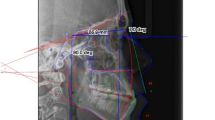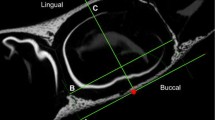Abstract
The purpose of this study was to investigate the relationship between standard cephalometric landmarks and lines and those using ovale, rotundum, greater palatine and infra-orbital foramina as references. Thirty-four children dry skulls, 19 males and 15 females aged 0–6 years, were examined by computed tomography scanning. The classical cephalometric dimensions of skull base were measured from middle sagittal plane crossing over basion, nasion and sella turcica. Those of hard palate (maxilla and palatine bone) were measured from axial plane intersecting posterior nasal spine and anterior nasal spine. The dimensions between ovale and rotundum foramina, rotundum and infra-orbital foramina, greater palatine and infra-orbital foramina were determined by using constructed tomographic planes enclosing these different foramina. Biostatistical analysis using partial correlations showed that the linear variables with nerve canal openings as references are strongly related to length of both the skull base and of the hard palate. The results highlight the importance of the nerve canal openings of skull base and bone facial components in normal or pathologic craniofacial growth investigations.







Similar content being viewed by others
References
Crocquet M, Laude M, Thilloy G (1993) Morphogenetic role of the trigeminal nerve. A new approach to facial architecture. Bull Assoc Anat 77:5–8
George SL (1978) A longitudinal and cross-sectional analysis of the growth of the postnatal cranial base angle. Am J Phys Anthropol 49:171–178
Guyot L, Richard O, Adalian P, Bartoli C, Dutour O, Leonetti G (2006) An anthropometric study of relationships between the clival angle and craniofacial measurements in adult human skulls. Surg Radiol Anat 28:559–563
Järvinen S (1984) Saddle angle and maxillary prognathism: a radiological analysis of the association between the NSAr and SNA angles. Br J Orthod 11:209–213
Kerr WJ, Hirst D (1987) Craniofacial characteristics of subjects with normal and postnormal occlusions—a longitudinal study. Am J Orthod Dentofac Orthop 92:207–212
Kjaer I (1989) Formation and early prenatal location of the human mental foramen. Scand J Dent Res 97:1–7
Kjaer I (1989) Prenatal skeletal maturation of the human maxilla. J Craniofac Genet Dev Biol 9:257–264
Kjaer I (1990) Ossification of the human fetal basicranium. J Craniofac Genet Dev Biol 10:29
Kjaer I (1990) Correlated appearance of ossification and nerve tissue in human fetal jaws. J Craniofac Genet Dev Biol 10:329–336
Lang J, Maier R, Schafhauser O (1984) Uber die postnatale vergrösserung der foramina rotundum, ovale et spinosum und deren lageveränderungen. Anat Anz 156:351–387
Melsen B (1987) Anatomy and development of the pterygopalato-maxillary region, studied in relation to Le Fort osteotomies. Ann Plast Surg 19:16–28
Nie X (2005) Cranial base in craniofacial development: developmental features, influence on facial growth, anomaly, and molecular basis. Acta Odontol Scand 63:127–135
Ricciardelli EJ (1995) Embryology and anatomy of the cranial base. Clin Plast Surg 22:361–372
Ross C, Hennenberg M (1995) Basicranial flexion, relative brain size, and facial kyphosis in Homo sapiens and some fossil hominids. Am J Phys Anthropol 98:575–593
Ross CF, Hennenberg M, Ravosa MJ, Richard S (2004) Curvilinear, geometric and phylogenetic modeling of basicranial flexion: is it adaptative, is it constrained? J Hum Evol 46:185–213
Sejrsen B, Jakobsen J, Skovgaard LT, Kjaer I (1997) Growth in the external cranial base evaluated on human dry skulls, using nerve canal openings as references. Acta Odontol Scand 55:356–364
Sejrsen B, Kjaer I, Jakobsen J (1996) Human palatal growth evaluated on medieval crania using nerve canal openings as references. Am J Phys Anthropol 99:603–611
Sperber GH (1989) The cranial base. In: Craniofacial embryology, 4th edn. Butterworths, London, p 101
Tanabe Y, Taguchi Y, Noda T (2002) Relationship between cranial base structure and maxillofacial components in children aged 3–5 years. Eur J Orthod 24:175–181
Varella J, Koski K (1990) Trigeminal foraminal pattern in the face. Acta Anat 138:208–211
Author information
Authors and Affiliations
Corresponding author
Rights and permissions
About this article
Cite this article
Harnet, JC., Lombardi, T., Lutz, JC. et al. Sagittal craniofacial growth evaluated on children dry skulls using V2 and V3 canal openings as references. Surg Radiol Anat 29, 589–594 (2007). https://doi.org/10.1007/s00276-007-0237-x
Received:
Accepted:
Published:
Issue Date:
DOI: https://doi.org/10.1007/s00276-007-0237-x




